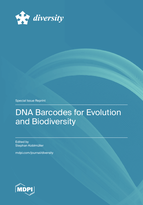DNA Barcodes for Evolution and Biodiversity
A special issue of Diversity (ISSN 1424-2818). This special issue belongs to the section "Phylogeny and Evolution".
Deadline for manuscript submissions: closed (15 January 2023) | Viewed by 44487
Special Issue Editor
Interests: conservation biology; biodiversity; genomics; ecology and evolution; DNA sequencing; DNA
Special Issues, Collections and Topics in MDPI journals
Special Issue Information
Dear Colleagues,
The world is currently facing an unprecedented loss of biodiversity. As highlighted in the latest IPBES (Intergovernmental Platform on Biodiversity and Ecosystem Services) global assessment report on biodiversity and ecosystem services, about 1 million animal and plant species are currently threatened with extinction. Biodiversity, however, is not something static, but rather dynamic and sensitive to changing environmental conditions. For documenting, maintaining and monitoring changes in biodiversity and its numerous functions it is necessary to be able to identify which entities contribute to biodiversity. For many taxa a reliable species identification, the prerequisite for studying biodiversity, is, if at all, only possible by taxonomic experts, whose numbers have been drastically declining over the last few decades.
DNA barcoding is a method for identifying specimens (ideally to species level) employing an expert based reference system (open access database) that drastically increases the number of people able to identify organisms down to species level and reduces the rate of misidentifications among morphologically similar taxa. Spcifically, DNA barcoding is a standardized approach for identifying organisms based on specific sections of their DNA. Depending on the taxonomic group, different genes have been established as the standard DNA barcoding markers even though for certain applications or taxa also other genes might be used). Consequently, DNA barcodes should allow for (in most cases) an unambiguous specimen identification (also of morphologically unidentifiable life stages/sexes or parts of organisms) once a reliable DNA barcode reference data base is available and thus is an important tool in basic and applied biodiversity and evolutionary biology research.
This Special Issue shall provide a platform to highlight new research and significant advances in DNA barcoding (incl. metabarcoding, eDNA, etc.) and its relevance for biodiversity and evolutionary biology research. In addition to empirical studies, submissions that focus on new methods, technologies and analyses that aid in the generation and application of DNA barcoding data are also highly welcome.
Dr. Stephan Koblmüller
Guest Editor
Manuscript Submission Information
Manuscripts should be submitted online at www.mdpi.com by registering and logging in to this website. Once you are registered, click here to go to the submission form. Manuscripts can be submitted until the deadline. All submissions that pass pre-check are peer-reviewed. Accepted papers will be published continuously in the journal (as soon as accepted) and will be listed together on the special issue website. Research articles, review articles as well as short communications are invited. For planned papers, a title and short abstract (about 100 words) can be sent to the Editorial Office for announcement on this website.
Submitted manuscripts should not have been published previously, nor be under consideration for publication elsewhere (except conference proceedings papers). All manuscripts are thoroughly refereed through a single-blind peer-review process. A guide for authors and other relevant information for submission of manuscripts is available on the Instructions for Authors page. Diversity is an international peer-reviewed open access monthly journal published by MDPI.
Please visit the Instructions for Authors page before submitting a manuscript. The Article Processing Charge (APC) for publication in this open access journal is 2600 CHF (Swiss Francs). Submitted papers should be well formatted and use good English. Authors may use MDPI's English editing service prior to publication or during author revisions.
Keywords
- DNA barcoding
- biodiversity
- evolution
- species delimitation
- conservation
- monitoring
Related Special Issue
- DNA Barcodes for Evolution and Biodiversity—2nd Edition in Diversity (1 article)






